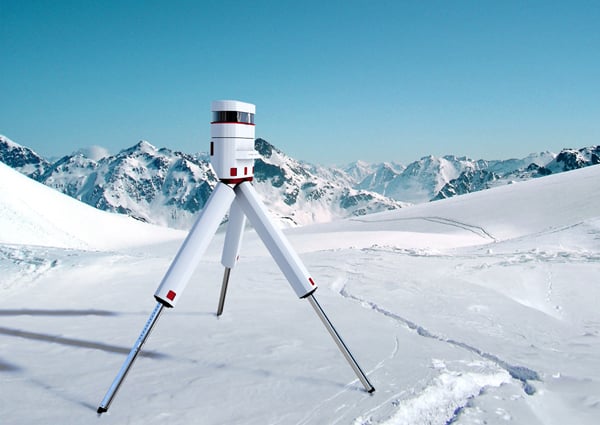
Glaciers worldwide are shrinking faster than ever before. According to a new research, one of the longest mountain range in Central Asia Tian Shan could disappear by 2050.The Celestial mountains have...
Designed to withstand the most extreme of conditions, Nevero is a portable laser based 3D measurement system for surveying glaciers. The technology warrants an extremely precise scan of fragile climate indicators. With an emphasis on lightness and comfortable portability, the design makes it easier for scientists and expedition crews to walk for miles up mountains to reach the scanning locations.
The device itself is divided into two parts. One is the laser scanner and the other is a bag which the scanner is transported in. The bag is a hard-shell concept based on carbon-fiber to make it as light as possible. It also has side-pockets for the extra storage of additional equipment.
The laser scanner has an integrated tripod which lifts the laser head up to 110 cm. It can be easily assembled with just two buttons for each leg. The laser head itself is protected by a glass that allows a 360 degree scan. The glass, in turn, is protected against damage by a ring of carbon-fiber that slides down when in use. On the backside of the scan device, there is a display for adjustments that is protected by its own keyboard. The link element on the back side is the safety feature that insures that the scanner and the bag are strongly connected and can only be separated by pressing the two big release buttons.
Designer: Carlos Schreib







-
Yanko Design
Timeless Designs - Explore wonderful concepts from around the world!
Yanko Design Store - We are about more than just concepts. See what's hot at the YD Store!
(Icy Tech was originally posted on Yanko Design)
Related posts:
Amazon's Santa Monica press conference is still a few hours out, but some news has already begun to flow, starting with a fairly minor tidbit from Pogoplug. Beginning today, the company will be offering a new cloud storage solution, powered by Amazon's Glacier service. Two Family plans are available, including 100GB of storage for $29 or a full terabyte for $99, each billed annually. For a limited time, you'll also get a free Pogoplug device with either Family plan. Enterprise customers can opt for a Team plan -- prices start at $199 per year for five users and five terabytes of storage -- but it's unclear whether or not you'll score a $50 appliance there. Head over to the source link below to sign up.
Update: We previously stated that the $29 plan included 100MB of storage, however the correct amount is 100GB. This misprint has been corrected.
Filed under: Storage, Internet
Pogoplug adds Amazon Glacier-based cloud storage, includes gratis devices with $29 and $99 Family plans originally appeared on Engadget on Thu, 06 Sep 2012 09:00:00 EDT. Please see our terms for use of feeds.
Permalink | Pogoplug | Email this | Comments
Pogoplug | Email this | Comments If you’ve got massive amounts of historical data to backup and have had trouble finding a low cost storage solution, then you should check out Amazon Glacier.

There are plenty of archiving services out there, but most of them will cost you a lot of money, compared to what Glacier is offering. Glacier’s data vault is a lot slower, but it will cost you just a penny per gig per month. This amounts to 10% of what Amazon charges for its S3 storage service. There are no setup fees, and Glacier can handle petabytes without any problems. However, the service is designed for data that is infrequently accessed and where retrieval times of several hours are acceptable. Accessing more than 5% of your data per month costs $0.05 per 1,000 requests. Requests take between three and five hours to process, and that’s before they’re ready to download.
It’s a safe way of backing up all your precious photos, music, and other stuff that’s vulnerable to a hack or data loss, which could be irreplaceable if not properly archived in redundant systems.